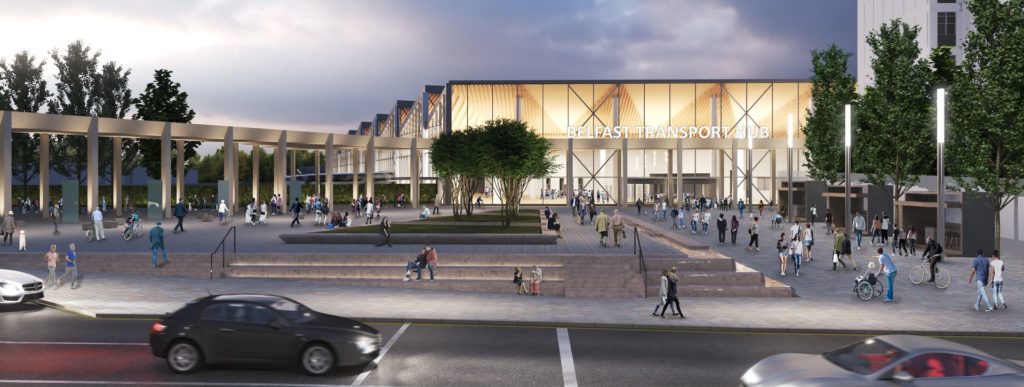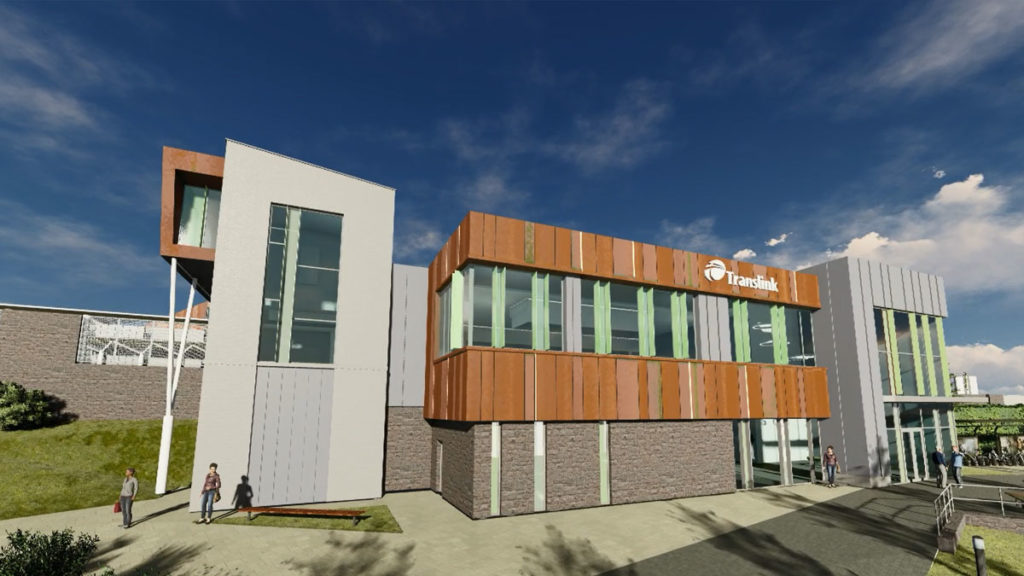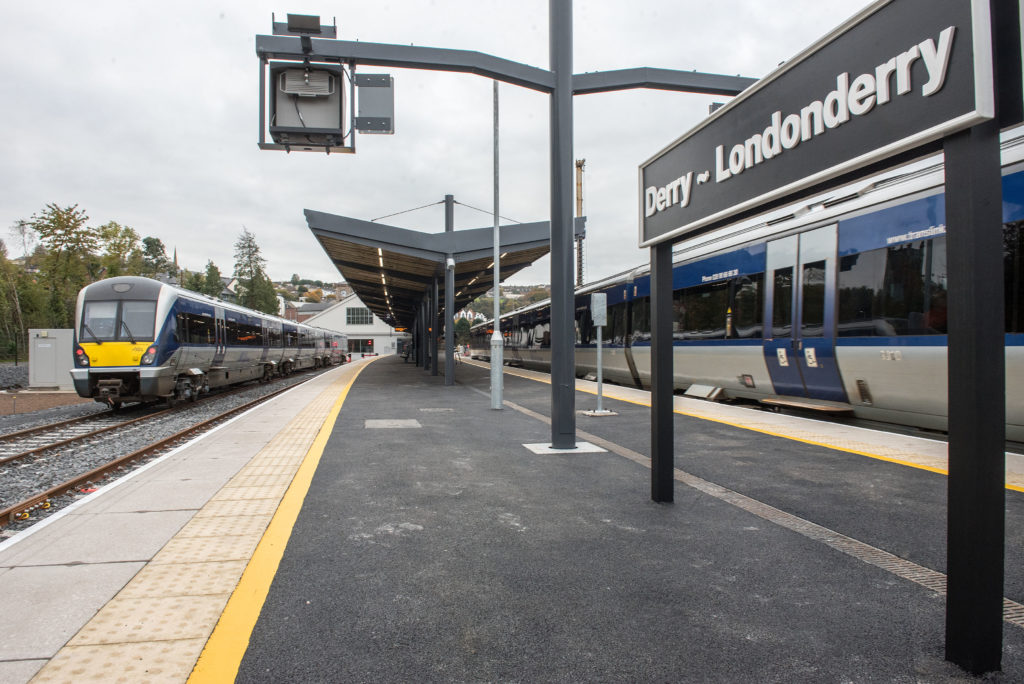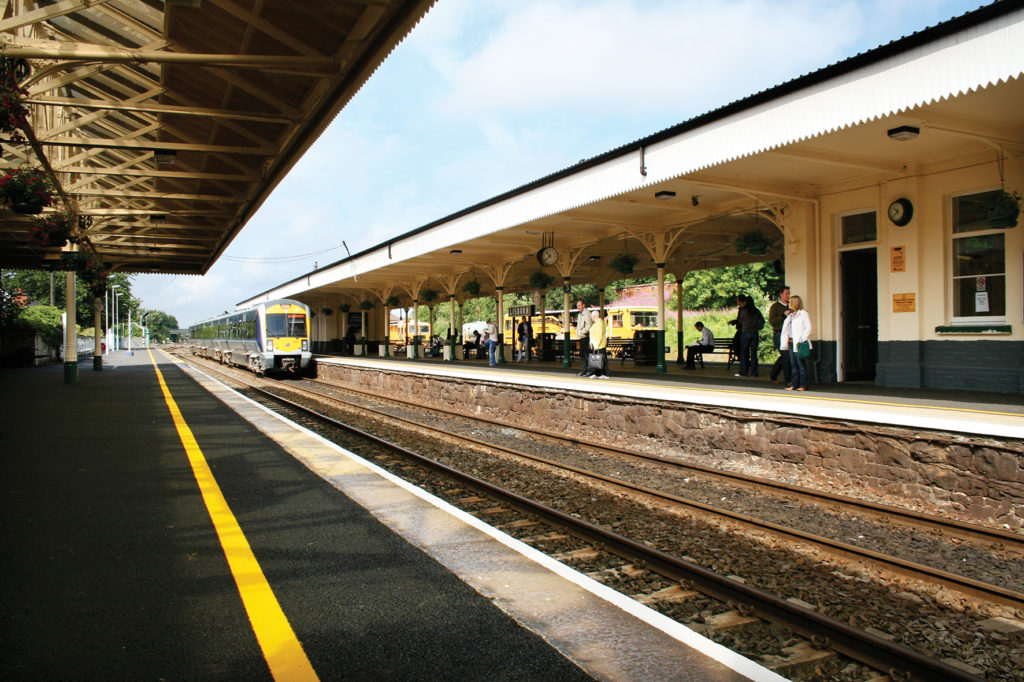Having experienced passenger growth of 130% over 12 years, Northern Ireland’s stations needed urgent attention.
The Northern Ireland network carried 15 million passengers in 2018, with growth having hit 130 per cent over a 12-year period. Trains and stations were becoming increasingly crowded and investment was needed. Tim Casterton reports on how operator Translink has tackled the constraints on its stations.
During the five years prior to the COVID-19 pandemic hitting the world economy, the number of passengers using Translink’s Northern Ireland Railway (NIR) service had been increasing dramatically. This is down to several reasons, including increased traffic congestion in Belfast, new trains and improved rail timetables.
In total, 21 new carriages have been ordered to increase train accommodation, but the stations were not forgotten as several key locations around the network were already at capacity and needed urgent attention. New park and ride locations were also looked at to help reduce congestion.
The Belfast stations – a brief history
By the late 1960s, history had left Belfast with various terminal stations on a much-reduced network. The formation of Northern Ireland Railways became the turning point, with the Bangor-line services being linked, in 1976, to the former Great Northern services via the then virtually disused former ‘Central Railway’. Belfast Central station (now Lanyon Place) was opened and Queens Quay and Great Victoria Street stations simultaneously closed.
New stations were opened on the former ‘Central Railway’ at Botanic (November 1976) and City Hospital (October 1986), serving key locations in central Belfast.

The Larne line and NCC (Northern Counties Committee) route to Londonderry used York Road station until 1992, when the new Yorkgate station was opened, along with the Cross-Harbour link, allowing services access to Central station.
By the start of the current decade, with Belfast Central being re-named Lanyon Place and the more centrally located Great Victoria Street having re-opened in September 1995, circumstances had changed and passenger numbers increased dramatically.
Great Victoria Street – the ‘central station’
These days, you have to wonder why the perfectly located Great Victoria Street station was ever closed, with its very central location in the City, but, back in 1976, the situation was very different and the diversion and integration of services to the then newly opened and secure Central Station was logical. Sensibly, though, the area and track beds were retained, so as to enable a new station on the site to be re-opened just short of 20 years later.
The Good Friday Agreement in 1998 brought a new and stable peace to Northern Ireland and that, without doubt, brought an increase in demand for travel and tourism and released the latent demand for rail travel.

Twenty years after re-opening the four-platform Great Victoria Street station, just a few minutes’ walk from the Europa Hotel and with the Europa bus station adjacent to it, it had outgrown itself as the new lynchpin of the NIR network and has become quite restrictive, so the Belfast Transport Hub project was born. Planning permission for the development, submitted in June 2017, was finally granted by the Department for Infrastructure on 21 March 2019.
The new £150 million Belfast Transport Hub, one of the NI Executive’s flagship projects, is to be built on the former Great Northern Railway goods yard. The scheme will take around five years to complete and will provide employment for over 400 people during construction.
Designed by John McAslan + Partners, along with Arup, this project will double the capacity of the station, with four additional platforms. Enterprise cross-border services will be diverted to the new hub from Lanyon Place station. The passenger facilities will also be expanded and further integrated with the adjacent bus station, which will be enlarged by fifty percent. Cycle storage and links to the cycle network are included and also ‘Belfast Bikes’ cycle hire facilities.
The Weavers Cross Development, adjacent to the station, will also bring additional commuters through it. Within the station, enhanced passenger waiting areas, improved accessibility, baby change rooms and new ticket vending machines will be provided.
Belfast Lanyon Place
Lanyon Place station (previously ‘Central’) is on the east side of the city centre, adjacent to the River Lagan. Now used by 2.6 million passengers annually, it needed a post-troubles refresh.
By September 2018, the main entrance had been modernised and the ‘blast wall’ removed and replaced with a far more welcoming frontage. Inside, the ticket hall was modernised and improved, with retail and café outlets provided. Externally, a new ‘Belfast Bike’ dock has been installed.
To be more reflective of its location, following completion of the works, the station was renamed ‘Belfast Lanyon Place’, after the 19th-century architect who had designed the nearby Custom House and several railway buildings in Ulster.
Yorkgate
Yorkgate station was opened in 1992, to replace the former LMS NCC York Road station, as part of the Cross Harbour line project to join the Larne line (and, since 2003, the Londonderry line) to the Portadown and Bangor lines.
The station, located in north Belfast, is to be redeveloped with improved passenger and staff facilities and the layout enhanced and designed to accommodate future passenger growth.
The proposal for the new high-quality transport hub is currently out for voluntary pre-application consultation, which is being undertaken by Translink. The proposal includes a new station building, wider platforms with canopies, a new footbridge, toilets and baby-change facilities, retail outlets and landscaping areas of the exterior.

Once redeveloped, the station will deliver improved accessibility and better links to walking and cycling routes, as well as providing enhanced connections to the new nearby Ulster University Campus.
Derry/Londonderry
In the North West, improvements to the Derry/Londonderry line had caused capacity issues, particularly at Londonderry Waterside station. In 2012, service reductions had been threatened on the route west of Coleraine due to poor track conditions. However, the then NI Regional Development Minister reallocated the A5 road duelling money to pay for the track works.
The line closed for nine months for a complete relay and foundation rebuilding which was completed in March 2013.
The second phase included resignalling and relocation of the passing loop from Castlerock to Bellarena station, allowing services to double from every two hours to an hourly service to and from Belfast from July 2017. This resulted in a staggering 37 per cent increase in the number of passengers using services between Coleraine and Derry/Londonderry. In perspective, the line carried just 500,000 passengers in 2002 – this had increased to over three million by 2018.
As a result of the increased passenger numbers, the 1980s-built Waterside station could no longer cope with the throughput, having experienced a 61 per cent increase in use over two years. Translink looked to see what could be done and, in a popular move, eventually decided to re-purchase the vacant former 1873-built Belfast & Northern Counties Railway Waterside station, a Grade B listed building designed by John Lanyon. This was restored and incorporated into the new enlarged Waterside transport hub.
The opening of the new platforms and diversion of trains from the 1980s station to the new site took place in October 2019, as a first stage of the £27 million project. The new track and platform layout offers greater flexibility and now has the capacity to handle additional trains, such as the Belmond Grand Hibernian hotel train.

The Lanyon train shed building no longer has trains in it. Instead, it is used wholly for passenger and staff accommodation and includes an information point, ticket facilities and a coffee shop. The project also includes secure cycle parking, a 100-space car park and a bus turning circle.
A new Greenway will be constructed to link Waterside station to the City Centre and Foyle Street bus centre via the Peace Bridge. The project has been designed to make the station a gateway to the North-West region, a catalyst for the re-generation of the wider Waterside and Duke Street areas, and will integrate multimodal forms of transport to support business, leisure and tourism.
As for the postponed third phase of upgrade, NI Infrastructure Minister Nichola Mallon has commissioned a feasibility study to consider the introduction of half hourly train services on the Derry to Belfast railway line. The study will also examine the viability of establishing additional halts, along with park and ride facilities, at Strathfoyle, Eglinton/City of Derry Airport and Ballykelly.
Bellarena
In connection with the introduction of the hourly service to Derry/Londonderry, the passing loop on the single line at Castlerock required relocation to Bellarena, around 10 miles east of Derry/Londonderry station. This required relocation of the station from west of the level crossing to the east of it. Two new six-car-length platforms, with shelters and customer information screens, were provided and were opened to the public on 22 March 2016.
The official opening took place on Tuesday 28 June when Her Majesty the Queen, accompanied by The Duke of Edinburgh, unveiled a commemorative plaque on the new Down platform. The project was primarily funded by the Northern Ireland Executive with EU funding support – a topical point that seemingly didn’t go un-noticed by Her Majesty, being just a week after the EU referendum!
Portrush
Portrush, a popular holiday destination on the Atlantic Coast, with attractions nearby such as the Giants Causeway, is served by a single-track branch line from Coleraine. With over 620,000 passengers using the branch terminus per year, weighted in the summer, the station building from 1973 had become inadequate.
The 148th Open Golf Championship, scheduled to be held at the Royal Portrush Golf Club in July 2019, would put undue strain on the terminal, so a decision was made to have a complete rebuild completed in time for it. The Department for Communities (DfC) provided £4.7 million of the funding and the Department for Infrastructure (DfI) provided a further £0.9 million. The redevelopment of Portrush station was designated as one of the key regeneration initiatives for the town.
A new landmark three-platform station, fully accessible and allowing for future passenger growth, was designed. Platforms 1 and 2 were extended to accommodate six-carriage trains. Features include a new main concourse with an atrium which provides natural light, modern waiting facilities, better passenger information, cycle storage and improved signage to local amenities and attractions. The new station also has the only fully equipped wet room at any Translink station!
Although the station has three platforms, re-signalling in Coleraine in 2016 now means that normally only one platform is in use, unless special provisions are put in place to operate the service with a pilotman on trains and the signal box at Portrush especially opened.
The Eglington Street side of the station has newly constructed, stone-clad walls featuring images of the North Coast including the North-West 200motorcycle race, the air show, golf and costal views. In addition to the regular Northern Ireland Railways services, the Railway Preservation Society of Ireland has operated the popular ‘Portrush Flyer’ steam train excursions to the station on summer weekends for many decades.
Lisburn West – a new ‘park & ride’
The former Knockmore Halt was opened in 1932 on the former Great Northern Railway of Ireland line on the Portadown side of Lisburn. It was served primarily by services on the Lisburn to Antrim Branch line. However, when services to the branch were withdrawn, it could only be served by Belfast-bound services, as there was no Down platform on the main line. Northern Ireland Railways closed the halt completely on 25 March 2005.

Ten years after closure, housing and industrial development proposals west of Lisburn prompted Translink to submit a planning application for a new park and ride station at the site – Lisburn West. Located around 1½ miles west of Lisburn, the station was finally granted planning consent on 30 July 2020 by Lisburn and Castlereagh City Council. This had initially been deferred in February whilst assessments of road traffic generated by the project were updated.
The consent for the station provides for Up and Down platforms and a loop platform face using the Antrim branch line, which can be used to turn-back services. A footbridge will incorporate the ticket office and staff facility. The 372-space car park includes 22 disabled parking spaces and two electric car-charging points. The design includes a bus turning area.
A Translink spokesperson has advised RailStaff that “the project will now be progressed, subject to funding and other business priorities”. The proposal complements the council’s plans for sustainable development around fast-growing West Lisburn, an area where there is already much employment and the re-opening is expected to attract further investment post COVID-19.
Report by Tim Casterton

